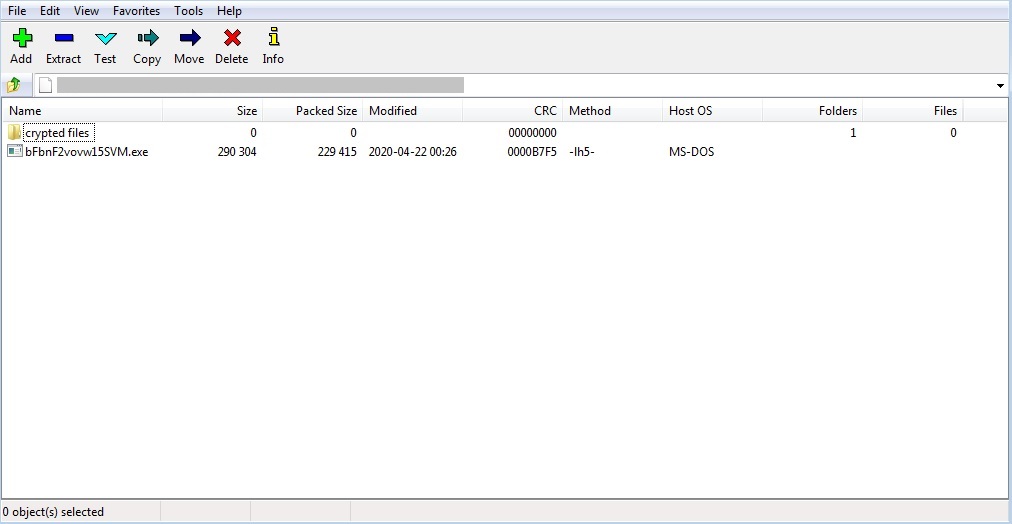Loki Info Stealer Propagates through LZH Files
 Insights and analysis by Miguel Ang
Insights and analysis by Miguel Ang
The malicious LZH file attachment comes from an email posing as a payment confirmation advice from a bank. The attachment is named “payment confirmation.lzh”.

Figure 1. Sample email delivering Loki through LZH attachment
The LZH archive attachment contained the Loki dropper named bFbnF2vovw15SVM.exe. It also has a folder named “crypted_files,” which contains an empty folder named “myself_crypted” inside. This was either the result of an error in archiving the sample or was meant to be used to contain additional components or payloads.

Figure 2. Attachment contents

Figure 3. Contents of the “crypted files” folder
The Loki dropper uses .NET compiled binaries to add multiple layers of obfuscation. It eventually uses process hollowing to load and execute the main Loki payload. This method is reminiscent of the campaign that propagates Loki through CAB file attachments. The main Loki payload that it drops also has the same hash as the variant concealed through CAB files, indicating that both samples are under the same ongoing campaign.

Figure 4. Obfuscated compiled binaries
Detachment from malicious files
Cybercriminals can use a variety of file attachments to spread malware, ranging from more common file types like Word Document or PDF, to less familiar ones like CAB or LZH files. Regardless of the file type used to conceal it, the fact remains that malware can compromise systems, disrupt device performance, or steal data. The following best practices can help prevent malware infections:
- Do not download attachments or click links on emails from unknown sources. This may lead to the installation of malware. Users may check where the embedded links lead to by hovering the pointer over the link.
- Read emails carefully to gauge the credibility of its contents. Some giveaway signs of spam are bad grammar, misspelled words, and unfamiliar or spoofed email addresses.
- Avoid sharing contact details and other sensitive information on public web forums or social media.
- Trend Micro™ Deep Discovery™ Email Inspector – Stops email-based threats including spam, ransomware, and targeted attacks through advanced analysis and custom sandboxing.
- Trend Micro™ Email Security – Employs sandbox for unknown files and URL, email sender analysis and authentication, and checking of email header and content for signs of compromise.
- Trend Micro™ Cloud App Security – Protects file sharing from malware and controls sensitive data usage.
Indicators of Compromise
URL
hxxp://retrak.co[.]ke/psy/five/fre.php
| File Name | SHA-256 | Trend Micro Pattern Detection |
| bFbnF2vovw15SVM.exe |
e6adc1df97033110cdf1bd9e9763559fe17811e2234013e4d57fa23b6ddbb207 |
TrojanSpy.Win32.LOKI.TIOIBYTU
|
| payment confirmation.lzh | fb37c52635a47cacba754f811ec64937aa6da3c0ced0162c201748b38952e164 | TrojanSpy.Win32.LOKI.TIOIBYTU |
Like it? Add this infographic to your site:
1. Click on the box below. 2. Press Ctrl+A to select all. 3. Press Ctrl+C to copy. 4. Paste the code into your page (Ctrl+V).
Image will appear the same size as you see above.
Recent Posts
- Estimating Future Risk Outbreaks at Scale in Real-World Deployments
- The Next Phase of Cybercrime: Agentic AI and the Shift to Autonomous Criminal Operations
- Reimagining Fraud Operations: The Rise of AI-Powered Scam Assembly Lines
- The Devil Reviews Xanthorox: A Criminal-Focused Analysis of the Latest Malicious LLM Offering
- AI Security Starts Here: The Essentials for Every Organization

 Complexity and Visibility Gaps in Power Automate
Complexity and Visibility Gaps in Power Automate AI Security Starts Here: The Essentials for Every Organization
AI Security Starts Here: The Essentials for Every Organization The AI-fication of Cyberthreats: Trend Micro Security Predictions for 2026
The AI-fication of Cyberthreats: Trend Micro Security Predictions for 2026 Stay Ahead of AI Threats: Secure LLM Applications With Trend Vision One
Stay Ahead of AI Threats: Secure LLM Applications With Trend Vision One